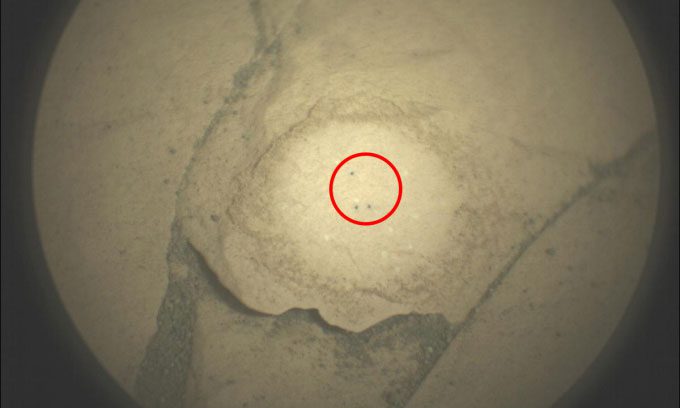NASA’s Robot Uses Laser to Etch a Capital Letter L on a Martian Rock to Mark Directions for Future Research.

Three small dots in the shape of an L created by the Perseverance rover using a laser on a Martian rock on June 17. (Photo: NASA/JPL-Caltech/LANL/CNES/IRAP)
When studying Martian rocks, even the smallest details become crucial. NASA plans to bring back rock samples collected by the Perseverance rover to Earth for further analysis. Therefore, in addition to the sampling location, NASA experts also need to determine the original orientation of the rock formations. To accomplish this, Perseverance has “etched letters” on the red planet.
Perseverance utilized the laser from the SuperCam instrument mounted on the rover’s tall mast to drill three holes in the shape of an L into a rock last June. This action was not random but served a clear scientific purpose.
Roger Wiens, a member of the SuperCam team, referred to this as the “first letter ever etched by laser on Mars” in a mission update on July 21. The announcement detailed why Perseverance needed to create such markings.
Perseverance is exploring an ancient river delta that may provide scientists with a unique opportunity to find evidence of past microbial life on Mars. This means that the rock samples collected here are particularly significant.
In addition to searching for signs of life, these samples could also help researchers understand the development of Mars’ magnetic field and its impact on the atmosphere. They want to know the orientation of the rocks to comprehend the initial directions of magnetic domains within the samples.
For rocks with easily recognizable features, determining orientation is quite straightforward, according to Wiens. “However, if the surface is fine-grained, there may be nothing to distinguish its rotational direction. In this case, we need to create artificial markers on the surface,” he explained. Rocks with fine-grained surfaces from the ancient river plains are ideal candidates for testing this method.
The team chose the capital letter L as a simple and effective way to mark direction. “With this successful experiment, we are ready to use this process to mark samples in the future,” Wiens noted.


















































